- Home
- Nevil Shute
The Rainbow and the Rose
The Rainbow and the Rose Read online
FIRST VINTAGE INTERNATIONAL EDITION, DECEMBER 2010
Copyright © 1958 by William Morrow & Co. Inc
All rights reserved. Published in the United States by Vintage Books, a division of Random House, Inc., New York. Originally published in book form in Great Britain by William Heinemann Ltd., London and in the United States by William Morrow & Co. Inc., New York, in 1958. This edition first published in Great Britain by Vintage Books, an imprint of The Random House Group Limited, London, in 2009. Copyright © The Trustees of the Estate of Nevil Shute Norway.
Vintage is a registered trademark and Vintage International and colophon are trademarks of Random House, Inc.
This is a work of fiction. Names, characters, places, and incidents either are the product of the author’s imagination or are used fictitiously. Any resemblance to actual persons, living or dead, events, or locales is entirely coincidental.
eISBN: 978-0-307-47415-5
www.vintagebooks.com
v3.1
Acknowledgement
The sonnet by Rupert Brooke, ‘The Treasure’, from 1914 & Other Poems, is printed by permission of Messrs Sidgwick & Jackson, Ltd.
Contents
Cover
Title Page
Copyright
Acknowledgement
Epigraph
Chapter 1
Chapter 2
Chapter 3
Chapter 4
Chapter 5
Chapter 6
Chapter 7
Chapter 8
When colour goes home into the eyes,
And lights that shine are shut again
With dancing girls and sweet birds’ cries
Behind the gateways of the brain;
And that no-place which gave them birth, shall close
The rainbow and the rose:–
Still may Time hold some golden space
Where I’ll unpack that scented store
Of song and flower and sky and face,
And count, and touch, and turn them o’er,
Musing upon them; as a mother, who
Has watched her children all the rich day through,
Sits, quiet-handed, in the fading light,
When children sleep, ere night.
Rupert Brooke
1
John Pascoe must have created something like a record for a pilot in civil aviation, because he went on flying a D.C.6b across the Pacific from Sydney to Vancouver as a senior captain of AusCan Airways till he was sixty years old. The Department of Civil Aviation stuck their toes in then. They couldn’t stop him flying because he was still perfectly fit and could pass every medical test they could think up. Perhaps they were afraid of what the papers might say if there should ever be an accident. At any rate, they refused to renew his licence for regular airline flying, on the score of age. He took his pension and bought three small aeroplanes out of his savings, and formed himself into a small aero club and superphosphate spreading company at Buxton in Tasmania. Flying was his whole life and he had few other interests, so he went on flying.
He was unmarried; back in the dark ages before ever I knew him there had been a divorce. He was the healthiest man of his age that I have ever met; at the time of his retirement he used no spectacles and still had all his own teeth. He was a very good tennis player. He was athletic in most ways; on his summer leaves he used to go on packhorse trips into the Canadian Rockies for the fishing, and at Nandi in the Fiji Islands where he was based in his last year of airline flying he did quite a bit of skin-diving, using an aqualung. I knew him for nearly thirty years; in fact, he taught me to fly when I was eighteen at Duffington aerodrome near Leacaster where my father was a solicitor.
Buxton is a little place in north Tasmania where the aerodrome is a grass field with no runways. I went there once before Johnnie Pascoe’s time. I was flying a D.C.3 from Hobart to Melbourne in the winter in deteriorating weather when an oil pipe on the port engine split just as I was starting on the crossing of the Bass Strait, so that I had to stop that engine. I didn’t feel like going on across a hundred miles of sea like that and Area Control agreed with me quite quickly when I put my problem to them on the blower. Hobart had closed in by that time and Launceston wasn’t too good, so they sent me in to Buxton which has dead flat country all around. I slithered in over the fence and put her down and boy! was I glad to be on the ground! So were the passengers.
I don’t think the population of Buxton can be more than three thousand, though it is the centre of a prosperous grazing district. It has one hotel, so bad that the commercial travellers avoid it and drive long distances to do so. It’s not a place that I would care to live in personally, but I’m not Johnnie Pascoe. There was quite a bit of minor flying to be done there, though, and I suppose that’s why he went. He had a Tiger Moth fitted up with a canister for spreading fertiliser from the air and he did a bit with that, and he had two Austers for instruction and occasional charter flights. He had a ground engineer called Billy Monkhouse to look after these three aeroplanes, who was nearly as old as he was. He lived in a small house just by the aerodrome and got a woman in each day to do for him; he went duck shooting with the locals in the autumn and trout fishing with the Shire Clerk in the spring. He got the sort of life he wanted, I suppose.
He always looked about the same, from the time I first remember him when I was a boy. He would have been about five foot nine in height with partially grey hair, regular features, rather a fine face, very tanned, a little lined towards the end. He hadn’t got a very great deal of humour in him, rather stiff. Women liked him, but I don’t know that he liked them very much; at any rate, he gave the impression of being careful. ‘Once bit, twice shy,’ he told me once, and I suppose he was speaking of the divorce. ‘But that doesn’t seem to stop one being bitten …’
He was born a Canadian, in Toronto I believe. He went to England as a flight cadet to train with the Royal Flying Corps in 1915 and he never went back to Canada – not to live, that is, though he must have passed through it often enough. He lived and worked in England and the Far East all the time between the wars, but it was as a Canadian that he got his job with AusCan after the Second War. All the pilots on that line had to be either Australian or Canadian for some point of politics.
Well now. I emigrated to Australia when I got married just after the Second War. I was in the motor trade at first, but then I got a job instructing with the aero club at Ballarat which got me back into the aircraft world. I joined Australian Continental Airways some time ago, and I’ve been a captain with them for the last five years. In July of last year I was on the Sydney-Melbourne run flying a Viscount with Dicky Powell as first officer. On that tour I used to take up Flight 82 in the late afternoon, get a three hour break in Sydney, and bring the last flight back, Flight 156 that left at 20.25 and got to Essendon at half past ten at night. I didn’t like that duty much, for several reasons. One got to Sydney after the shops shut and with too little time to go into the city for a movie. If possible I like to be at home in the late afternoon because of reading to the kids before they go to bed. One sees so little of them, otherwise. I like to help them making models, dressing dolls, and all that sort of thing. Instead, I had to stick around for three hours at Kingsford Smith airport five hundred miles away from them, reading a book in the pilots’ room, listening to the radio, or just snoozing in a chair.
That year we had a terrible July. I was sitting there one evening half asleep, listening to the radio and the wind outside and the rain beating on the window. The seven o’clock news was just coming on, and I stayed to listen to that before going in to tea. I sat dozing through all the stuff about Egypt and the Middle East, and all the stuff about the floods along the Murray
. Then there came a bit that jerked me suddenly awake. The announcer said something like this:
‘It is reported from Tasmania that a pilot flying a small aeroplane upon an errand of mercy crashed this afternoon on a small airstrip on the west coast. The pilot, Captain John Pascoe, was attempting to land to bring a child into hospital, Betty Hoskins, aged seven, who is suffering from appendicitis. There is no practicable land route to the Lewis River and all communications normally take place by sea, but no vessel has been able to enter the river for the last ten days owing to the continuing westerly gales. Captain Pascoe is reported to have sustained a fractured skull.’
I was a bit upset when I heard this news. We all knew Johnnie Pascoe because for a time Sydney had been one of his terminals and he still passed through now and then. The world of aviation is a small one in Australia. But I knew him better than anyone, of course, because I had known him off and on for thirty years, ever since he taught me to fly in England at the Leacaster Flying Club. In 1942 I had met him in Cairo when he was flying a courier service to England in a Hudson. In 1944 he had flown me back to Lyneham from Calcutta in a Liberator after I got shot up in Burma. I had met him many times since then, particularly in Australia. All through my life I had known Johnnie Pascoe, quiet, grizzled, and competent. He was a part of my experience.
When I went for briefing and ran through the flight plan with Dick Powell I asked the Control Officer, ‘Did you get any more on Johnnie Pascoe than was on the news?’
‘Not much,’ he said. ‘Hobart sent a machine out just before dark, but it didn’t get far. It’s clamped down over the mountains.’
‘Is it right he got a fractured skull?’
‘So they say.’
‘They got that over the radio?’
‘That’s right. They’ve got a transceiver at the Lewis River.’
I had already got the weather gen for my flight, but I went back and saw the Met Officer again. I asked him, ‘What’s the form for tomorrow – on the west coast of Tasmania? I’m wondering how they’re going to get Johnnie Pascoe out.’
He turned to his chart, and stood tapping his pencil against his teeth, silent. Then he laid it on the chart. ‘There’s this depression stationary at the eastern end of the Bass Strait. It’s been there for four days. There seems to be another forming down to the south-west – here.’ He traced a little circle on the chart. ‘Might push it away.’
‘Get a clear interval before the second one comes up?’
‘We might. I could tell you better tomorrow morning. If we do, it’ll deteriorate again. It’s like that at this time of year, of course.’
I went out to the aircraft and put all this out of my mind. You must do that and I had got into the habit of it years before; when you’re doing pre-flight checks you only want to think about the pre-flight checks. It was a miserable night with a strong gusty south-west wind that was going to make us fifteen minutes late on schedule, with drifts of rain lashing against the machine.
Presently I got my clearance from the Tower and taxied out to the runway, and took her off. When we were on our way and climbing upon course I had time to think about Johnnie Pascoe again, and the more I thought the less I liked my thoughts. The west coast of Tasmania must be one of the most inaccessible districts in the world. It’s only about a hundred miles from Hobart but there are no roads there at all and only one bush track that you can walk along, and that doesn’t go within forty miles of the Lewis River. The mountains stick up in pinnacles all over the country, sort of haphazard, not in definite ranges. The valleys that meander in between and all around these islands of mountain are filled with bush so dense that you cannot penetrate it on foot but have to cut your way through yard by yard with a machete. When you get towards the coast you come upon occasional plains, but these are button-grass plains where no feed grows that will sustain a horse. You can’t work a horse in that country at all. If you want to get in to the Lewis River you must go on foot packing all you need for the next fortnight on your back, hacking your way through the horizontal scrub yard by yard. Or you can go round the coast in a fishing boat if the weather is good enough for entering the estuary, which is uncharted and unbuoyed. Or you can fly in to their tiny airstrip. That was what Johnnie Pascoe had tried to do.
We flew at twenty-three thousand feet, and even at that height we had a rough trip. When we were half an hour from Melbourne I spoke to Essendon Tower and got clearance to let down. We were the only aircraft in the air that night, so when we were steady on the let-down I spoke to the controller again and asked if there was anything fresh on Johnnie Pascoe.
‘We’ve been monitoring their frequency,’ he said, ‘but there’s been nothing fresh. I don’t suppose there will be till the morning. The woman’s there alone.’
‘What woman?’ I enquired. ‘Over.’
‘They’re tin miners,’ he explained. ‘Mr and Mrs Hoskins and two children. They’ve got a surface working. They just dig up earth and wash the tin out of the soil, I think. They’ve got a diesel-engined boat. Don Hoskins took it round to Hobart a fortnight ago to fetch stores, leaving his wife and children in the house. Now he can’t get back.’
I frowned. ‘They’ve got some neighbours? Over.’
‘There’s not another house for thirty miles.’
‘For the love of Mike!’ I said. ‘Who’s looking after Johnnie Pascoe?’
‘The woman is,’ he replied. ‘She pulled him out of the machine and got him to the house.’
I thought very quickly. ‘What’s the strip like?’
‘They land an Auster there in fine weather,’ he said. ‘Somebody was saying it’s only about a couple of hundred yards long, on top of a little hill.’
‘Is there a data sheet for it?’
‘I think there might be. Would you like me to look and see?’
‘I wish you would. I’ll come up to the Tower when we land.’
We got in to Essendon at about a quarter to eleven. I waited till the passengers were all off and then left the machine myself, hurrying through the rain to our office. The weather was even worse here than it had been at Sydney, as dark as pitch and with quite a high wind. In the warmth and light of the office I glanced at the movements board. There was a Dakota freighter scheduled to leave for Hobart in Tasmania at one o’clock in the morning. I asked the night clerk if that flight was still on, and he told me they were loading the machine.
I left the office and ran through the rain to my car in the park, and drove to the Tower. The controller was up there waiting for me. He had the data sheet for the Lewis River airstrip on his desk, and he handed it to me. ‘It’s not a licensed field, of course,’ he said.
It certainly wasn’t. The plan showed it as one tiny runway six hundred and thirty feet long, little more than two hundred yards, and only forty feet wide. It ran approximately north-west and south-east, more or less across the prevailing wind. The approaches were quite unobstructed, and it had a hard surface. It was built upon a ridge because the ground fell away quite steeply towards the west; at one point it was marked: ‘Cliff 50 ft.’ only a few yards from the runway. To the east the slope was more gradual and here was the legend: ‘Ground soft and uneven’. The homestead was marked upon the plan about a quarter of a mile from the strip, and a secondary plan showed the general position of this lot in relation to the Lewis River and the surrounding country. There was a mountain two thousand four hundred feet high about four miles to the north-east which might be a bit of a trap for young players in bad weather, and a lot of little hills and escarpments dotted about. The altitude of the strip was five hundred and thirty feet above sea level.
The rain beat and drummed on the glass walls of the control room all around us as I stood looking at this data sheet, taking it all in. ‘It’s pretty small,’ I said at last.
He nodded. ‘They don’t use it much. The Hobart club fly in to take them the mail once a week, but they don’t very often land. Generally they drop the mail and parcels as they fly ov
er. They do land light aircraft there, though, in fine weather.’
I waved the data sheet. ‘This is the only strip in the vicinity?’
He nodded again. ‘They used not to have a strip at all. Then they made this about two years ago. I suppose it was the best that they could do. It’s a big job, of course, just for one man and his wife.’
I stood there, thoughtful, looking down on Runway 260, still lit up. ‘Any more on Johnnie Pascoe?’
‘Not since I spoke to you. I should say they’ve closed down for the night. They’ll be speaking on the morning schedule, at seven o’clock.’
I turned to him. ‘How did all this begin?’
‘The kid got sick two days ago,’ he told me. ‘The mother got on the radio about it, and they got the doctor on the other end. He diagnosed appendicitis, and said she’d got to be brought into hospital at once.’
‘Easier said than done.’
‘That’s right. Rhys-Davids knows the form out there better than anyone. He’s the pilot-instructor at the Hobart club. Actually, he’s the only man who’s ever landed an aircraft on that strip, and he’s the one who always takes their mail. He’s in hospital with a hernia, and they won’t let him out till next week. He had the operation on Monday.’
That’s the sort of thing that always happens, of course.
He went on, ‘They sent a machine out from Hobart, twice. They couldn’t make it over the mountains either time, and they hadn’t got the range to go round the south coast in anything that could make a landing on the strip. Then Pascoe said he could make it from Buxton. It’s about a hundred and ten miles from Buxton, flying down the coast from the north. He tried early yesterday morning in an Auster. It was clear when he took off, and raining heavily by the time he got there – visibility less than half a mile. He waited for it to clear, circling over the sea until his fuel was getting low, and then came back to base. He went off again yesterday afternoon.’ He paused. ‘The woman said that he made three attempts to land – touched his wheels each time and took off again. The fourth time, she said, the machine turned upside down in a gust and fell off the edge of the runway.’

 On the Beach
On the Beach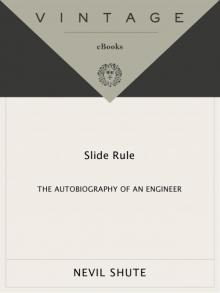 Slide Rule
Slide Rule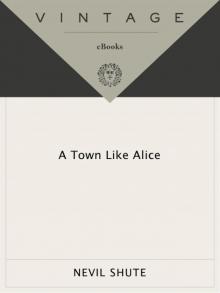 A Town Like Alice
A Town Like Alice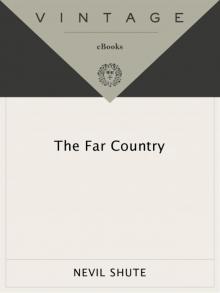 The Far Country
The Far Country Pied Piper
Pied Piper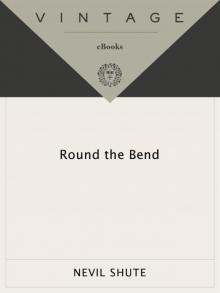 Round the Bend
Round the Bend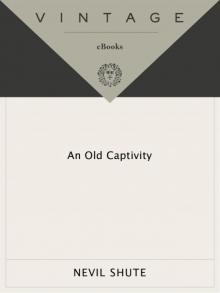 An Old Captivity
An Old Captivity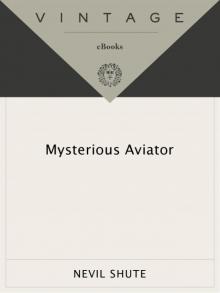 Mysterious Aviator
Mysterious Aviator The Breaking Wave
The Breaking Wave Marazan
Marazan Lonely Road
Lonely Road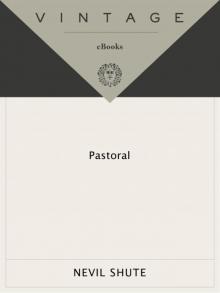 Pastoral
Pastoral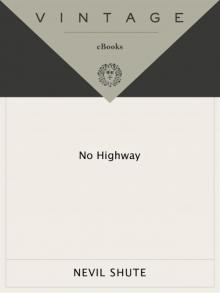 No Highway
No Highway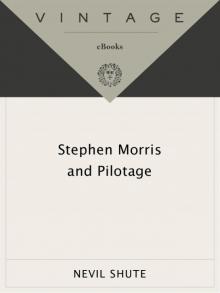 Stephen Morris and Pilotage
Stephen Morris and Pilotage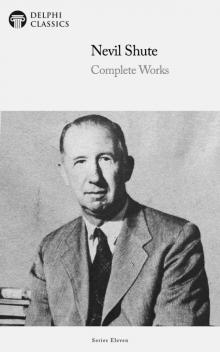 Complete Works of Nevil Shute
Complete Works of Nevil Shute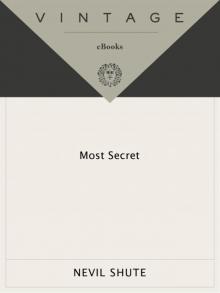 Most Secret
Most Secret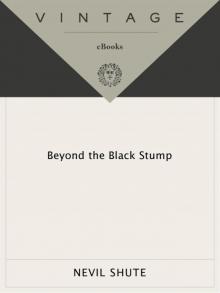 Beyond the Black Stump
Beyond the Black Stump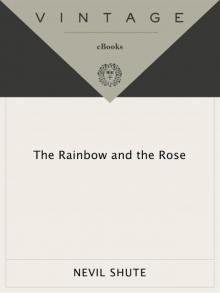 The Rainbow and the Rose
The Rainbow and the Rose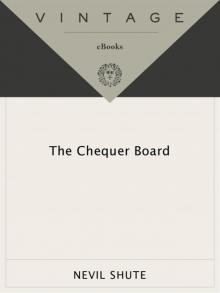 The Chequer Board
The Chequer Board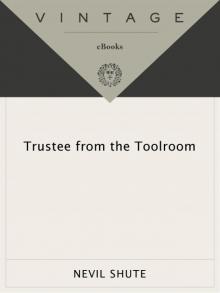 Trustee From the Toolroom
Trustee From the Toolroom Ordeal
Ordeal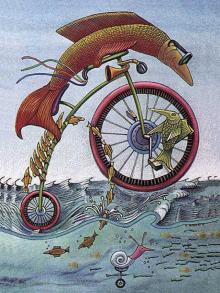 Stephen Morris
Stephen Morris